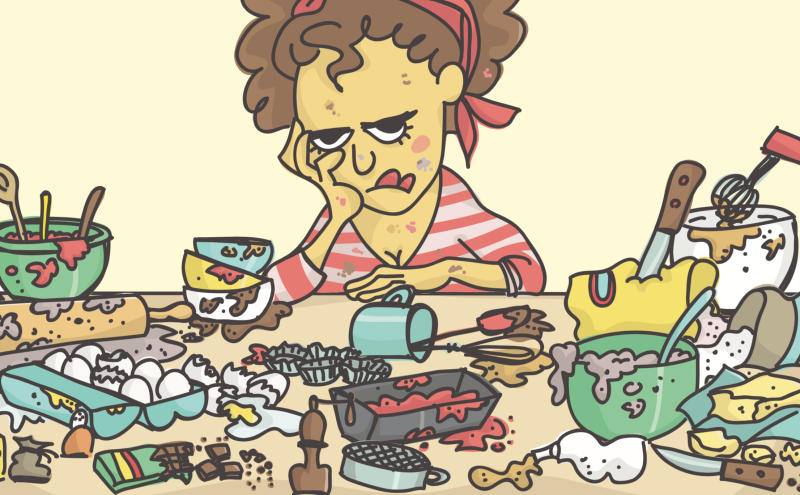By now, you’re probably not making rookie mistakes like adding food to a cold pan, cooking meat straight from the fridge, or not letting meat rest after it’s cooked, but you’d be surprised at the things you may still be doing wrong in the kitchen. Here are eight cooking mistakes you could be making.
Undersalting Pasta Water

The Chew taught me a lot of things. Carla Hall taught me there’s flavor in the brown. Clinton Kelly taught me to skewer a hole into a lemon for fresh juice, which is now trending on TikTok. Michael Symon taught me to let meat get to room temp before cooking it. Daphne Oz was always subbing avocado to make things healthier, and Mario Batali taught me to salt my pasta water like the sea.
RIP to The Chew, which sunk with Batali’s reputation, but the disgraced chef’s liberal salting technique still stands. Literally, it should taste like saltwater—like taking a dip in the ocean. Once the water is boiling, add at least two tablespoons of kosher salt per pound of pasta. Check out our Cooking School for more pasta hacks, like why you should never strain noodles over the sink.
Undersalting in General

You are not a real home cook until you have a salt cellar next to your stove full of Morton’s or Diamond Crystal kosher salt. The former is denser, while the latter is a little lighter and flakier. Contrary to popular belief, salt does not make your food taste salty. Instead, it brings out the flavor of your ingredients. Season from start to finish, adding salt one three-fingered pinch at a time at the various stages before and during cooking.
Speaking of which, be sure to taste the food as you go instead of just at the end. Otherwise, by the time you realize something is missing or needs to be adjusted, it may be too late. If you accidentally go overboard, a splash of vinegar can help counterbalance the salt with acid.
Having Your Mise All Over the Place

I have a little song I sing when getting out all of the things I’ll need to prepare a meal. It goes, “mise en place, mise en place, I like my mise en place” and repeats. Why is it so important to have your mise en place, aka everything in its place? Because there’s nothing worse than getting midway through a recipe and realizing that you’re out of xyz or don’t own a tool that’s needed to complete the dish, especially if you live far from a store. You also don’t want to be reaching in the fridge, pantry, or spice cabinet for another ingredient when your hands aren’t clean.
Be prepared and organized by reading the recipe all the way through before you shop, then make sure all of your ingredients for the entire meal are out, washed, and prepped before you begin combining ingredients and cooking.
Not Parboiling Potatoes

Parboiling is the method of partially cooking food by boiling until it is soft. Next time you’re craving roasted potatoes, try boiling them in salted water for five to 10 minutes until fork-tender before throwing them in the oven. This way, the insides get nice and fluffy while the outside gets nice and crisp for a satisfying crunch without frying.
Adding All Alliums Simultaneously

As you’ve probably noticed, garlic cooks way faster than onions do. However, many recipes say to add these two alliums to the pan at the same time, leading to burnt, bitter garlic. If you’re just sweating them out on low heat, feel free to add them both simultaneously, but if you’re sauteeing, add the garlic when you’re at least halfway done cooking the onions.
Ignoring Acid

I am so guilty of omitting the acid from the balance of salt, fat, acid, and heat, but it makes all the difference. Just think of how much better salmon tastes with a squeeze of lemon than without. Almost any veggie, meat, or fruit dish can benefit from a splash of vinegar or citrus, which balances out sweet, fatty, salty, bitter, or starchy tastes. Find out more about how acidity affects the flavor of your food here.
Holding Your Knife Too Far Back

Laura Bennett/Oola
We all know that good quality, sharp knives are best, but are you sure that you’re holding your chef’s knife correctly? Many home cooks need to choke up on the knife blade a bit, which helps with dexterity, stability, and control. As Fine Cooking instructs, “Hold the handle with your middle, ring, and pinkie fingers. Rest your index finger flat against the blade near the handle (curl the finger back toward the handle), and position your thumb on the opposite side of the blade.”
Starting with Mediocre Ingredients

Good food starts with sourcing quality ingredients. Fresh is always better than frozen. Fresh pasta is a million times better than boxed. Purchase what’s in season—preferably from the farmers’ market, not the supermarket. Seasonal food is not only fresher, but it’s also usually more affordable.
Sure, pre-shredded cheese is easier than shredding your own, but that convenience comes with a cost. Not only are there additives to keep the cheese from sticking together, but those additives keep the cheese from melting like the real deal. Buy olive oil that actually tastes good on its own, real lemons as opposed to fake lemon juice, real vanilla vs. extract, and imported bay leaves. Bay leaves from Turkey have a much smoother flavor than bitter domestic leaves from California, which tend to taste like menthol. When you start with the best, freshest ingredients possible, you don’t have to do much to make them taste great.
